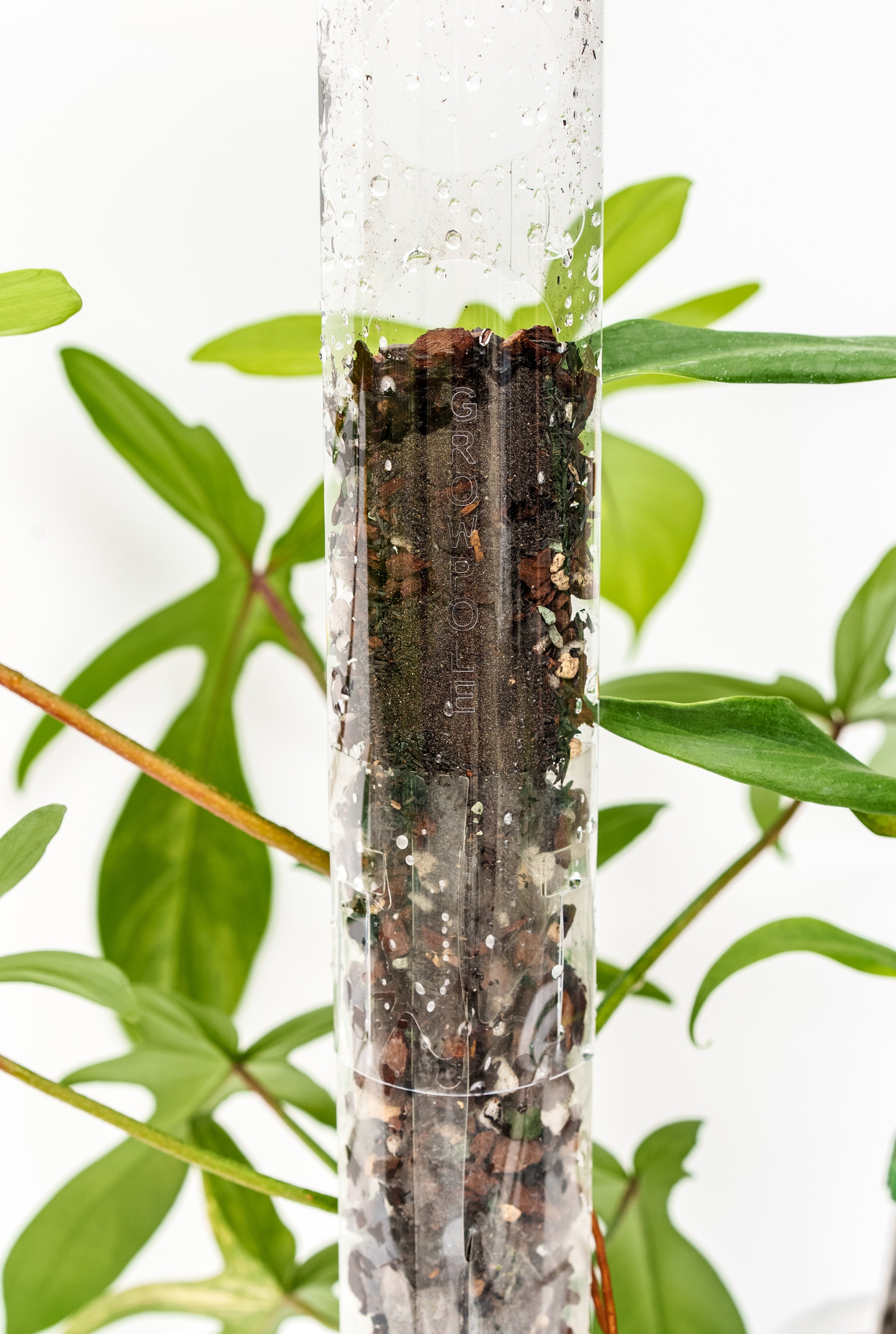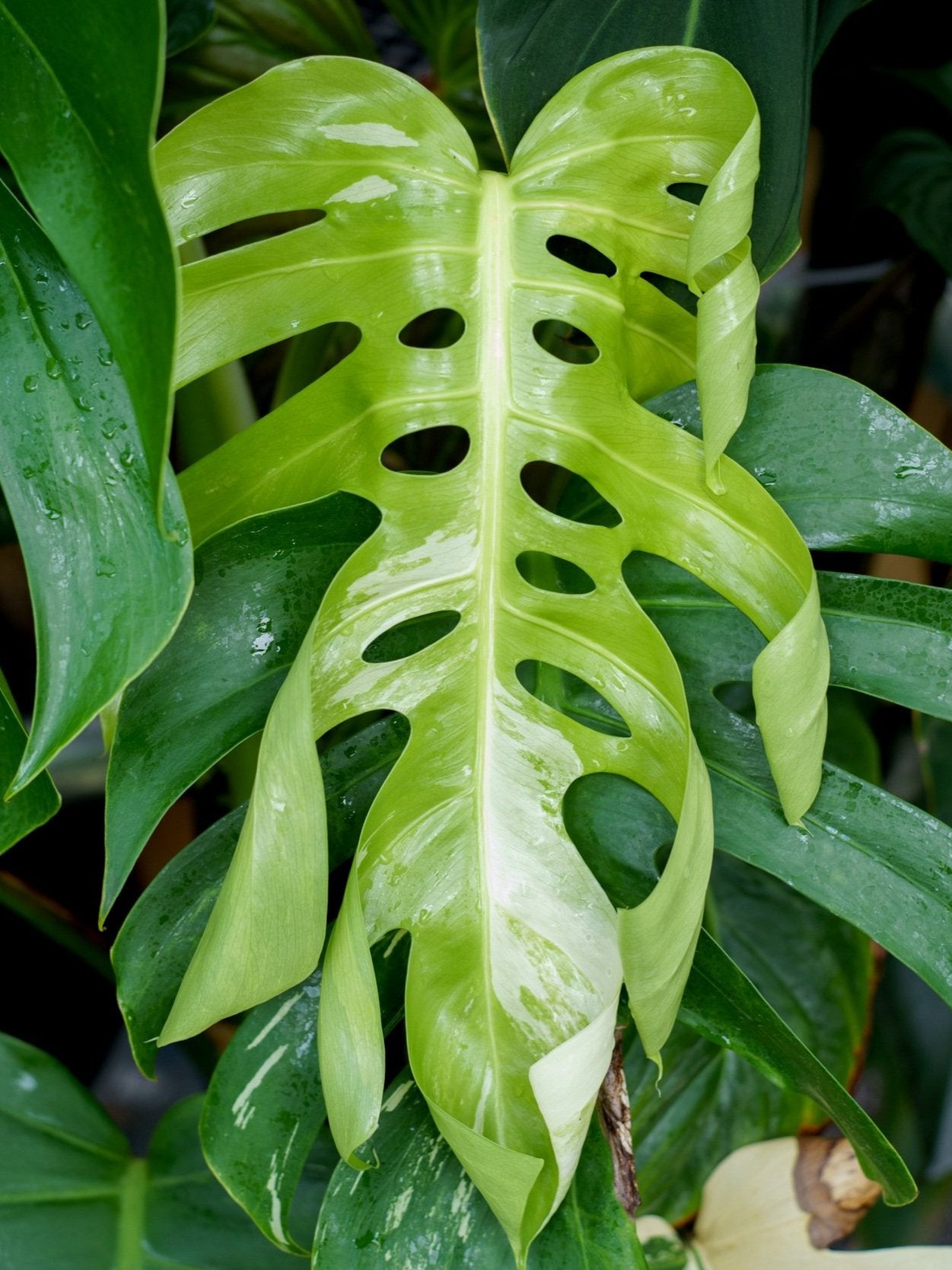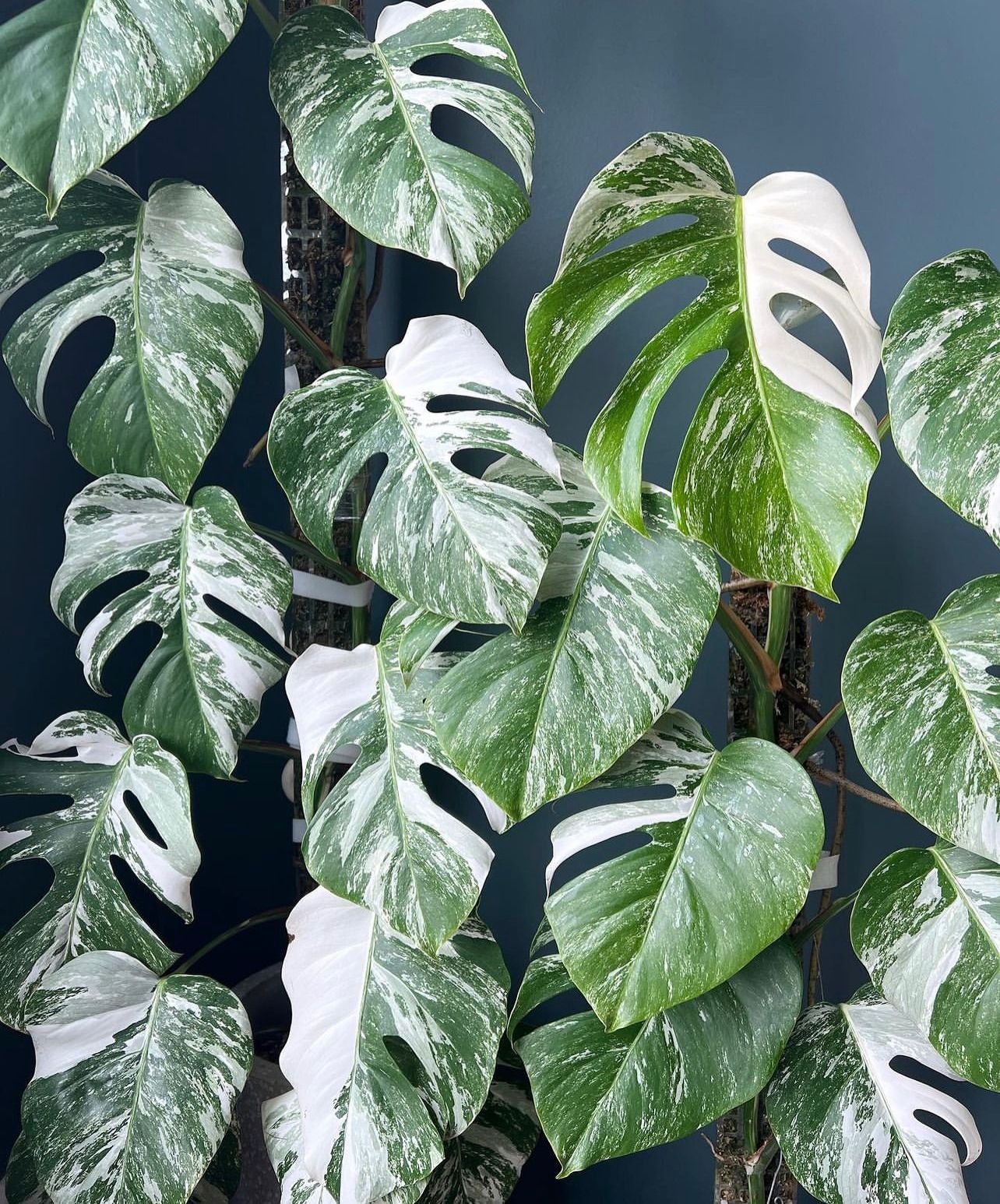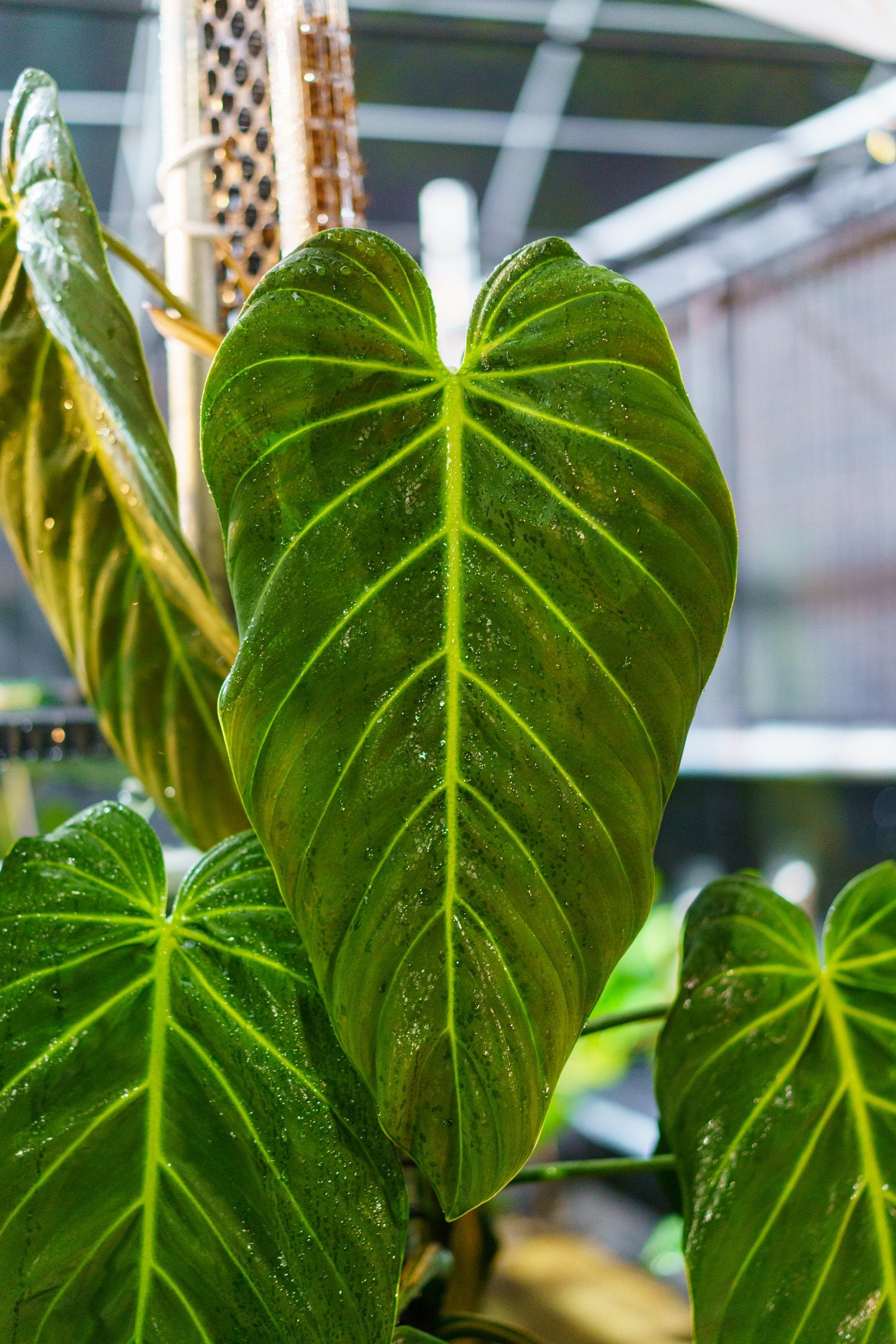
Thiccly GrowPole Species Guide
THICCLY GrowPole Species Guide is a non-exhaustive compilation of aroid types suitable for our range of products. It is based on over 2 years of research, growing the species indoors and outdoors, as well as valuable user feedback and research.
Overview
This guide lists popular climbing species of Monstera, Philodendron, and Anthurium suitable for use with GrowPole supports. The plants are grouped by their recommended GrowPole size, from Small to Large, based on typical indoor growth and the plant’s potential under ideal conditions.
Each entry includes growth notes comparing the size a hobbyist can expect versus the size attainable in the wild or under perfect conditions, to help manage expectations.

Monstera (Climbing Species)
Monstera are vigorous climbers with iconic fenestrated leaves. In nature they scramble up trees and can reach enormous sizes. Indoors, their leaf development and ultimate size will depend on conditions and the support given.
Generally, a larger GrowPole with optimal humidity and light will allow Monsteras to achieve bigger, more mature foliage.
Right: A variegated Monstera Borsigiana leaf showing multiple layers of fenestration on a Large GrowPole. Clones on a smaller pole did not reach this level of maturity.
Below is a list of notable Monstera species/cultivars, sorted by recommended pole size:
Recommended Pole Sizes
Monstera obliqua (Peru form)
GrowPole Size: Small
Tiny, delicate leaves (often under 6″). Extremely slow growing; even in the wild leaves rarely exceed a foot. Best kept on a Small pole to maintain humidity.
Monstera dubia (Shingle Plant)
GrowPole Size: Small
Shingling climber with juvenile leaves ~2–4″ that press flat on a surface. Requires a board or pole to mature. Leaves remain small under indoor conditions.
Monstera siltepecana (Silver Monstera)
GrowPole Size: Small
Juvenile leaves ~3–5″ with silver pattern. Climbs as a shingler when young. Can develop larger, lobed leaves (~12″) if it climbs high in ideal conditions.
Monstera karstenianum (“Peru”)
GrowPole Size: Small/Med
Thick, quilted leaves ~4–6″ long. Slow climber; stays compact indoors. In very high humidity it may produce slightly larger leaves, but generally manageable size.
Monstera adansonii (incl. var. laniata)
GrowPole Size: Small/Med
Vigorous vine; leaves typically 4–8″ indoors. Can reach ~12–18″ leaves in ideal greenhouse conditions. A Medium pole can support larger fenestrated leaves if conditions allow.
Monstera standleyana (Philodendron Cobra)
GrowPole Size: Small/Med
Slender climbing vine with narrow waxy leaves ~5–7″, often variegated. Remains relatively small; will climb a pole but leaf size only modestly increases with support.
Monstera pinnatipartita
GrowPole Size: Med/Large
Develops very fenestrated leaves resembling a “skeleton”. In home cultivation leaves commonly reach ~1–1.5 ft. With high humidity and a large support, foliage can approach 2–3 ft with full fenestration.
Monstera borsigiana (incl. variegated Albo/Aurea forms)
GrowPole Size: Med/Large
Fast climber; similar to M. deliciosa but slightly smaller internodes. Indoors on a Medium pole it often maxes out at 1–2 palm-sized leaves (6–8″ diameter). Given a Large pole and ideal care, it can mature to 8+ palm-sized leaves with tertiary fenestrations (i.e. multiple rows of holes). Variegated forms tend to grow slower but follow the same trend.
Monstera deliciosa (“Swiss Cheese Plant”)
GrowPole Size: Large
In the wild can climb 20+ m high with leaves 2–3 ft wide. Indoors, commonly reaches 6–8 ft tall with leaves about 12–18″ wide. Needs a Large support for full split leaves. Given space and time, indoor leaves can approach 2+ ft, but will rarely reach wild size.
Monstera ‘Thai Constellation’ (variegated deliciosa)
GrowPole Size: Large
Variegated cultivar of M. deliciosa. Slower growing, but leaves can still attain ~1–2 ft indoors with good care. In perfect conditions it has the same potential as green deliciosa (3+ ft leaves), but expect smaller size in typical home environments. Requires Large pole for best development due to eventual leaf weight.
Philodendron (Climbing Species)
Philodendrons include many climbing aroids that dramatically increase in leaf size as they ascend. Most start with small juvenile leaves and, once given a pole or tree to climb, mature into much larger leaves.
Below we list a wide range of popular climbing Philodendrons, from compact species to giants, with the recommended GrowPole size. (Note: True crawling Philodendrons – those that creep along horizontally – are not included here but listed later, as they are not suitable for vertical poles.)
Recommended Pole Sizes
P. hederaceum (Heartleaf Philodendron, incl. micans)
GrowPole Size: Small
Classic vining philodendron with heart-shaped leaves ~2–4″ long. Stays small as a houseplant; climbs readily but leaves don’t dramatically size up (may reach ~6″ maximum in very humid, low-light conditions). Perfect for Small poles or trellises.
P. imbe ‘Burle Marx Fantasy’
GrowPole Size: Small
Miniature climbing cultivar with stiff, silver-green leaves only ~2–3″ long. Very slow grower. Even mature plants stay compact. A Small GrowPole provides ample support and humidity for its delicate aerial roots.
P. gloriosum × P. melanochrysum (Philodendron ‘Glorious’)
GrowPole Size: Small/Med
Hybrid of a crawler and a climber – it takes after the climbing parent. Leaves start ~4–6″ and can reach ~12–15″ given a pole and good humidity. More vigorous than gloriosum. Can go on Small pole initially; upgrade as leaves enlarge.
P. brandtianum (Brandi)
GrowPole Size: Medium
Compact climber with silvery patches on 5–7″ leaves. Readily climbs; leaves may slightly increase to ~8–10″ under ideal conditions. Typically remains manageable on a Medium pole. Prized for its color more than size.
P. sodiroi (Silver Leaf Philodendron)
GrowPole Size: Medium
Shingling juvenile phase with 4–5″ silver-heart leaves; later forms larger glossy leaves ~12″+. Indoors on a pole, leaves around 8–10″ are common. Needs medium support; can get bigger in greenhouse humidity (up to ~18″ leaves).
P. pedatum (Oak Leaf Philodendron)
GrowPole Size: Medium
Lobed green leaves; juvenile leaves ~6″, mature leaves deeply divided ~12–18″ across. On a Medium pole indoors, often achieves ~1 ft wide foliage. In wild trees leaves can exceed 2 ft. Medium pole suffices initially; may need Large if leaves become very large.
P. subhastatum
GrowPole Size: Medium
Climber with green topsides and red-purple undersides on leaves ~8–10″ long indoors. Will climb eagerly; leaves can double in size (to ~18″) if grown up a totem in high humidity. Medium pole is usually adequate for indoor growth.
P. erubescens ‘Pink Princess’
GrowPole Size: Medium
Popular hybrid with dark leaves variegated pink. Leaves ~5–8″ typically; can reach ~12″ with age. Does climb (vine habit) but stays relatively moderate-sized. A Medium GrowPole is recommended to maximize leaf size and variegation display.
P. erubescens cultivars (White Wizard, White Princess, White Knight)
GrowPole Size: Medium
Variegated philodendrons with similar habit to Pink Princess. Leaves ~6–8″ with striking white sectors. They climb but remain mid-sized; on a moss pole leaves can approach 10–12″ in ideal conditions. Medium pole supports them well.
P. hastatum (“Silver Sword”)
GrowPole Size: Medium
Metallic blue-silver lance-shaped leaves ~6–10″ long indoors. Fast grower; leaves can reach ~12–15″ in greenhouse conditions. Typically managed with a Medium support; will climb and thicken quickly.
P. squamiferum
GrowPole Size: Medium
Unusual species with red fuzzy petioles and oak-like lobed leaves. Indoors leaves about 8–12″ long; can get larger (to ~18″) when well supported. Medium pole is sufficient; appreciates humidity for aerial roots on petioles.
P. tortum
GrowPole Size: Medium
Dramatic deeply dissected “skeleton” leaves. Leaves ~8–10″ long indoors, potentially up to ~15″ in optimal humidity. Climbs well on a moss pole. Medium support recommended due to its moderate leaf size and slender form.
P. Florida Ghost (hybrid cultivar)
GrowPole Size: Med/Large
Hybrid with creamy new leaves that green up. Juvenile leaves ~5–7″; mature leaves (with lobes) can exceed 12″ under ideal conditions. Given bright light and a pole, leaf size and variegation improve. Often started on Medium pole, but may require Large if it achieves its full potential ghostly large foliage.
P. melanochrysum (Black Gold Philodendron)
GrowPole Size: Med/Large
Velvet emerald-black leaves that can become huge when climbing. Indoors, typically 8–14″ long leaves on a pole. In native habitat or greenhouse, leaves can reach 2+ feet. A Large pole encourages bigger leaves (up to ~24″), but a Medium/Large can suffice for most home growers given its 3–5 ft vine length indoors.
P. gigas
GrowPole Size: Med/Large
Giant velvety leaves; similar to melanochrysum but even larger potential. Has produced 70 cm (28″) leaves on a Medium GrowPole in high humidity. Leaves could grow larger on a Large pole, though very large gigas leaves can be floppy. We recommend Medium/Large support: medium for initial growth, upgrading to large as needed for structure.
P. esmeraldense
GrowPole Size: Med/Large
Rare, large heart-leaf philodendron. Under indoor conditions, leaves commonly 12–18″ long; in the wild can exceed 2 ft and very thick. Needs a robust pole as it sizes up. Best started on Medium; move to Large if leaves approach their wild potential.
P. verrucosum (incl. forms: “Amazon Sunset”, etc.)
GrowPole Size: Med/Large
Velvety green leaves with vivid veins, often ~8–12″ indoors. Can grow larger (18″+) in terrarium or wild conditions. Notoriously prone to leaf loss during shipping, but once established on a moss pole, it will climb fast. Medium pole often works, but in ideal conditions leaves may become dinner-plate sized, warranting a larger pole.
P. el choco red (P. verrucosum relative)
GrowPole Size: Med/Large
Velvet heart-shaped leaves with red abaxial (underside). Similar in size to verrucosum – ~10–14″ leaves in good indoor culture. With high humidity and climbing, leaves can push past 18″. Consider Medium to Large support depending on desired size.
P. joepii
GrowPole Size: Med/Large
Bizarre rare species with narrow “T-shape” leaves. Leaves can reach ~2 ft long in mature form. Slow growing; indoors often stays <18″ leaves. Provide Medium support initially; a Large pole if it ever nears full size. Primarily for collectors aiming for its unique leaf shape rather than maximum size.
P. billietiae
GrowPole Size: Large
Long, strappy green leaves with bright orange petioles. Commonly achieves 1–2 ft long leaves in cultivation. In ideal outdoor conditions, leaves up to ~3 ft long. A Large GrowPole is recommended for structural support, as even ~2 ft leaves are heavy. This species can truly reach impressive lengths given time and a tall support.
P. giganteum (“Giant Philodendron”)
GrowPole Size: Large
True to name – enormous glossy leaves. Indoors, leaves 1–2 ft wide are attainable on a big pole. In the right tropical environment, giant leaves 4–5 ft long by ~3 ft wide have been recorded. A Large GrowPole is required from the start; even then, expect more moderate indoor sizes (~2 ft) unless you have near-greenhouse conditions.
P. jose buono (Variegated)
GrowPole Size: Large
Large paddle-shaped green leaves with cream variegation. Leaves typically 1–2 ft long in indoor culture. Given its potential (some wild specimens over 3 ft), it should be on a Large pole to allow spreading and to showcase variegation. Manage expectations: variegated plants often grow slower and a bit smaller than all-green forms.
P. dark lord (Hybrid cultivar)
GrowPole Size: Large
Deep burgundy-black foliage, triangular leaves reaching ~1.5 ft long in enthusiast collections. Vigorous climber once mature. Use a Large pole for best results, as it will rapidly size up when well-fed – leaves can double in area as the vine thickens. Without ample support, leaves may not reach their full size or may flop.
P. sharoniae
GrowPole Size: Large
Dramatic elongated rippled leaves (often 2–3 ft long in mature specimens). This rare climber needs a tall, sturdy pole – its leaves get longer rather than much wider. In a botanical garden setting it can hang 4+ ft leaves. Indoor growers can expect ~2 ft leaves with high humidity and a Large GrowPole.
P. patriciae
GrowPole Size: Large
Stunning long corrugated leaves, drooping as they lengthen. Can reach ~3 ft long leaves in ideal conditions (and even longer in wild reports). A Large pole is a must to accommodate its vertical growth. Typically 1–2 ft leaves in indoor culture, but with time, it aspires to much larger – one of the reasons it’s so coveted
P. maximum
GrowPole Size: Large
One of the largest philodendrons – huge green leaves that can rival P. giganteum. Rarely seen fully grown outside its habitat; leaves in wild may exceed 4 ft. Even young cultivated plants have sizable leaves (~1+ ft). Provide a Large support and plenty of space. Manage expectations as it’s unlikely to reach “maximum” size outside a greenhouse.
P. spiritus-sancti (Santa Leopoldina)
GrowPole Size: Large
The holy grail of philodendrons – extremely rare. Long, slim green leaves that in nature reach ~2–3 ft long. In cultivation, often much smaller due to limited availability of mature specimens. If you are lucky enough to have one, a Large GrowPole and perfect care are needed to even approach its wild potential. Generally stays under 2 ft in private collections.
Anthurium (Climbing/Epiphytic Species)
Many Anthuriums are epiphytic plants that grow on trees or mossy surfaces, and while they don’t twine like philodendrons, certain species appreciate the vertical support and moisture of a GrowPole. Anthuriums can develop much larger leaves in high humidity and bright, indirect light.
The recommendations below focus on larger leaf “climbing” or epiphytic Anthuriums (as opposed to purely terrestrial, rosette types). These are sorted by the GrowPole size that will accommodate their typical cultivated size and allow them to thrive:
Recommended Pole Sizes
A. forgetii
GrowPole Size: Medium
Small velvet-leaf Anthurium with round, lobeless leaves (~4–6″). Self-heading but can attach aerial roots to moss poles for humidity. Indoors, leaves remain under 8″. A Medium pole helps maintain moisture around the plant, although it won’t “vine” upward much.
A. clarinervium
GrowPole Size: Medium
Compact heart-shaped leaves with white veins (6–8″ typical). Grows from a short creeping stem; not a true climber, but can lean on a pole or board. In ideal greenhouse conditions leaves may approach 10–12″. Medium support mainly serves to boost humidity and showcase the foliage.
A. crystallinum
GrowPole Size: Medium
Similar to clarinervium with slightly larger, thinner leaves (8–10″ common indoors). Appreciates mossy support to cling to; high humidity can yield leaves over 12″ wide, but generally a Medium pole suffices as leaves won’t get gigantic in normal home settings.
A. magnificum
GrowPole Size: Med/Large
Large velvet green leaves with pronounced veins. Leaves ~12–18″ in good indoor culture; in very favorable conditions can exceed 2 ft. A Medium pole can work initially, but a robust Large pole is ideal as the plant matures and leaves grow heavier. (Wild specimens reportedly have 2–3 ft leaves on tall petioles).
A. papillilaminum (“Ace of Spades”)
GrowPole Size: Med/Large
Dark velvety, spade-shaped leaves that can reach ~12–15″ long in cultivation. In situ, leaves may grow larger (reports of ~20″). Tends to crawl slightly, but can be trained upward on a damp pole for bigger leaves. Given its intermediate size, either a Medium or Large pole works – use Large if aiming for maximum leaf size and if your plant starts producing significantly larger leaves.
A. warocqueanum (“Queen Anthurium”)
GrowPole Size: Med/Large
Long, pendant velvet leaves. Can exceed 3–4 feet in length in ideal conditions, though 1–2 ft is more common in home cultivation. Requires very high humidity for large leaves. A Medium/Large GrowPole (or moss plank) provides essential support for its narrow, drooping leaves and keeps roots happy. Upgrade support as your “queen” matures.
A. veitchii (“King Anthurium”)
GrowPole Size: Large
Spectacular corrugated strap leaves. Indoors, mature leaves around 3 feet long are achievable. In the wild, leaves can be double that length (5–6+ ft). A Large GrowPole or board is strongly recommended so the plant can hang its heavy leaves safely. This king will eventually demand vertical space and strong support.
A. regale
GrowPole Size: Large
Majestic heart-shaped leaves with velvety texture. In nature leaves reach up to 2 m (6+ ft) long. In cultivation, leaves typically max out around 1 m (3 ft)given high humidity and time. A Large support is necessary to accommodate its huge, thick leaves and sprawling roots. Even with ideal care, expect perhaps 2 ft leaves indoors; anything larger is a botanical triumph.
A. luxurians
GrowPole Size: Large
Uniquely corrugated, bullate leaves that can grow 1+ ft long. It’s a slow-growing collectible species but can eventually produce very sizable, deeply textured leaves in terrarium-like conditions. Use a Large pole or mount to maintain high humidity around it. Not a fast climber, but its roots will cling to moist moss as it slowly gains size.
A. x Faustinomirandae (Giant Anthurium)
GrowPole Size: Large
An exceptionally large terrestrial/epiphytic Anthurium with leathery leaves that can reach 4–5 ft long in botanical gardens. Rare in cultivation; if grown, a Large support and pot are required. Typically stays smaller (~2 ft leaves) in homes due to lower humidity. Included here for its sheer potential – truly a giant that needs a giant support.
Crawling (Non-Climbing) Aroids - Not Suitable for GrowPoles:
Philodendron gloriosum, P. plowmanii, P. mamei, P. pastazanum, P. rugosum, and other “crawlsters” grow along the soil horizontally rather than upwards. These have a rhizome or stolon that creeps forward on the surface and will not latch onto a vertical pole. They prefer wide, shallow pots to accommodate their crawling growth.
Trying to force them to climb a pole can stress the plant (they’ll “fight you at every turn” to keep crawling). If you have these species, use a rectangular planter or trough to give their rhizomes room to run, instead of a GrowPole.

Indoor vs. Wild: Managing Growth Expectations
Climbing aroids often captivate us with photos of enormous wild specimens, but it’s important to understand the difference between typical indoor sizes and wild potential.
In nature, these plants have unlimited support, rainforest humidity, and decades to grow – Monstera deliciosa leaves can span 3 feet across in the jungle, while indoor leaves might stop at 1 foot. A Philodendron melanochrysum that climbs 40 feet up a tree may sport leaves over 2 feet long, yet a well-grown houseplant on a moss pole usually has leaves under 1 foot. Even with excellent care, most houseplants won’t hit their absolute maximum dimensions.
GrowPole recommendations err on the side of the “enthusiast-grown” size – the size you can realistically achieve in a home or hobby greenhouse. This helps you choose a pole that matches the plant’s display size in your conditions, rather than the theoretical size in perfect conditions.
Remember that providing a larger climbing surface (and optimal care) can indeed unlock more of the plant’s potential. For example, growers have found that a variegated Monstera given a Large GrowPole produced dramatically larger, more fenestrated leaves than genetically identical cuttings on a Medium pole. Similarly, a Philodendron that outgrows a medium support might continue expanding if transitioned to a taller, more robust pole. However, indoor plants self-limit their size based on environment – light, humidity, nutrients, and root space all play roles. Don’t be disappointed if your “Queen” Anthurium has 18″ leaves instead of 4 feet; in a living room, that may already be the plant reaching its comfortable apex.
Finally, always consider upgrading the support if your plant is thriving. One advantage of the GrowPole V3 (front-opening version) is that it allows you to easily remove and re-secure your plant when it’s time to “upsize” the pole. If your Monstera or Philodendron has exceeded its current pole and conditions are favorable, you can transition it to a taller or thicker GrowPole with minimal disturbance. This front-opening design makes it simple to clip the moss column around the established vines and aerial roots, giving your plant room to continue its ascent. By matching your plant’s support to its growth stage, you’ll ensure it stays healthy and stable – and you’ll be rewarded with a truly spectacular indoor jungle over time!

Sources:
The sizing and growth recommendations above are informed by the original THICCLY GrowPole guide, real-world observations from growers, and reputable plant care resources. Key references include documented cases of increased leaf size with larger poles, horticultural guides on species’ wild vs. indoor dimensions, and expert care articles (e.g. The Spruce, houseplant blogs) detailing maximum leaf sizes.
These citations highlight how optimal conditions and proper supports can influence growth. Always adjust expectations to your environment, and happy growing with your GrowPole setup!

